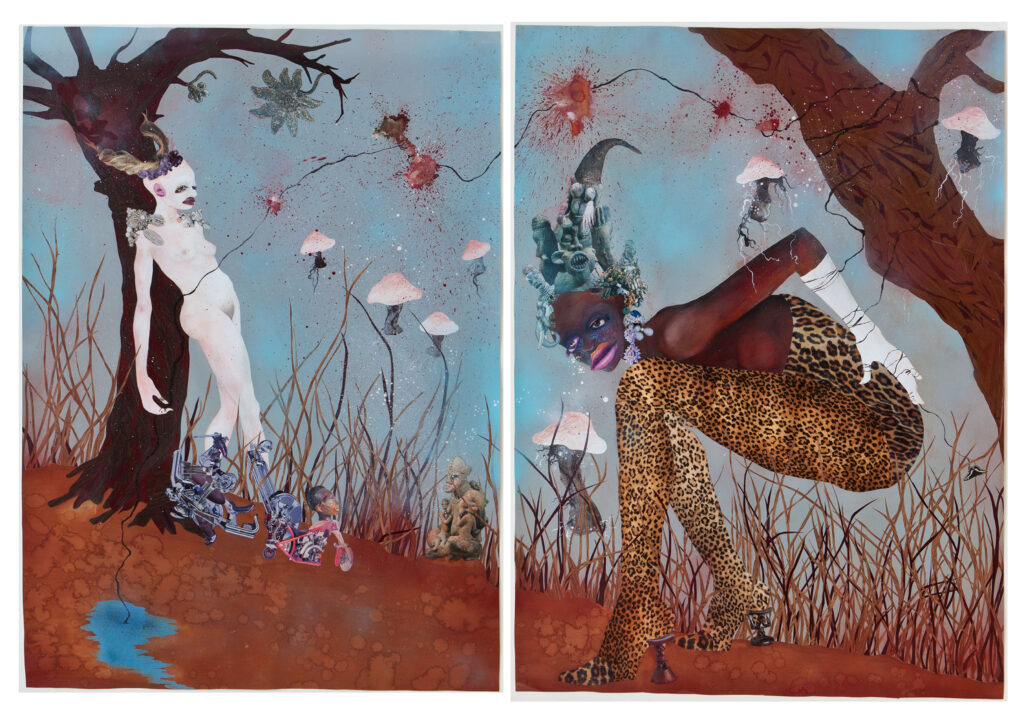Mutu Astonishes at the New Museum
An African master gets her Gotham blockbuster.

“Wangechi Mutu: Intertwined” will occupy six floors at the New Museum through June 4, enough time to visit more than once. Bring your friends, bring your lovers, bring yourself, because it’s doubtful that we will see its likeness again. A Wakanda-esque starship of more than 100 works curated by Vivian Crockett and Margot Norton and parked on a scruffy stretch of the Bowery, it is a phantasmagoria of daunting scale.
Ms. Mutu, born at Nairobi and educated at New York, has attained mastery in media as diverse as collage, installation, video, and sculpture. It adds up to an artistic practice shot through with voice and verve. Of Africa and focused on the feminine, her work manages fluency in both the prehistoric and futuristic tenses. She creates in the moment where the Big Bang and apocalypse converge, and neither curses nor enchantments are alien to her.
A helpful correction to both conceptual art that feels prankish and didactic social commentary masquerading as art, Ms. Mutu’s work is not so much incomprehensible as off-kilter, as if reality was altered by a spell that made it bloom in unpredictable directions. For her, Africa is less a place than an alternative dimension where even the soil is surreal.
Take “Sentinel VI,” from just last year. The towering figure could be an alien visitor or a vestige of a time when goddesses left footprints on the ground. A check for the materials of which she — the pronoun feels right — is composed discloses red soil, paper pulp, wood glue, emulsion paint, coral bean, dead base rock, gourd, brass ornament, plastic bead, tiger cowry, jawbone, chiffon, and brass bell.
The beads glitter against the packed dirt and her eyes are sourced from shells. Feathers hang from her head in a fashion that feels both ornamental and martial. Nearby is “Outstretched,” from 2019. This figure is reclining, lounging but not quite at rest. Charcoal gives her a dusty, ashen patina set against a smattering of feathers of bright pink. If “Sentinel” is watching, “Outstretched” is waiting.
“The Seated I” is a posture all her own. On loan from the Metropolitan Museum of Art, where it was commissioned for the mecca’s facade, the figure is slender and coiled, with one knee raised. The Met calls it “simultaneously celestial and humanoid, strange and familiar.” The show stopper is the gold disc at her mouth, a sun in miniature that recasts the organ of speech as a visual icon.

“The End of carrying All” is a nearly 11-minute film that weaves together animation and Ms. Mutu herself, traversing an unfolding landscape while increasingly burdened by items like a bicycle wheel, a satellite dish, a tower, an oil rig, and an entire city. She staggers but does not stop. Just when the reel risks didacticism — a woman’s burden made visible — it turns weird. Ms. Mutu transforms into an incandescent blob that seeps into the earth and erupts.
This theme of metamorphosis is a persistent one across Ms. Mutu’s oeuvre. “Crocodylus,” from 2020, is a mammoth bronze sculpture that depicts a woman riding a crocodile while merging with it, both of them possessed of a scaliness that suggests the two species have synched. The New Museum calls it a “composite science fiction machine that suggests both ancient wrath and futuristic biotechnology.” It is also gorgeous, sleek, and scary.
“Nyoka” is a basket, also of bronze, full of what appears to be a snake, all coiled reptilian musculature. Eerier is “Nywele,” which appears to be a knot of human hair transmuted into metal, and “Heads in a Basket” startles with its heads that resemble strewn mangoes the color of midnight. “Musa” is a human-ish, tailed creature, curled in a pool of water, at rest after the fashion of a fetus in the womb or a corpse in the grave.
Ms. Mutu is especially deft at collaging, a practice that harnesses her proclivity for juxtaposition, incongruity, and uneasy synthesis. “My Mountain My Mind” looks like a demon at her first Vogue shoot, and “Yo Mama” is an excursion into pink. Ms. Mutu calls it “an imaginary outer space” that features Funmilayo Anikulapo-Kuti, believed to be the first Nigerian woman to drive a car.
There are macroscopic sculptures of pathogens like Zika, dengue, and mumps, their magnification signaling the outsize role those pathogens play in Africa’s continent-wide battle with illness. The series, begun in 2017, lands differently after Covid, a years-long period when a virus ruled the globe. Another sequence of collages makes women’s visages from medical illustrations of uterine tumors.
“The Glider,” made of soil, charcoal, and paper pulp, is both human and boat, ship and passenger at once. The sculpture feels like it was built for motion, that even as it rests in the gallery it skims a sea only it can see. Its head resembles the prow of Viking ships, painted on before a dangerous journey so that the divine would be on board when the seas turned stormy. Like Ms. Mutu’s art, its course is set for destinations scarcely imaginable.

